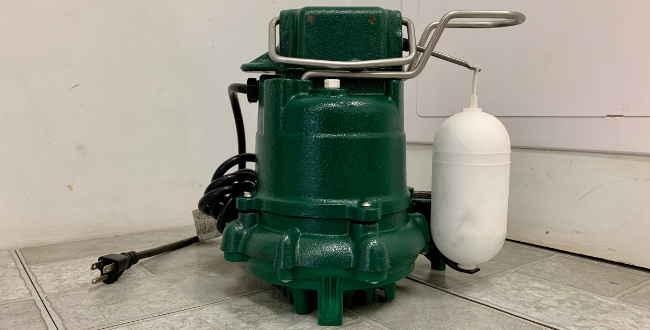Rain water needs to run somewhere, so relying on your sump pump to keep your basement or crawl space free of water is crucial, even through the most torrential of rain storms. The objective of a sump pump is simple: when water enters your basement, the pump pulls it away from the foundation and into your drainage system, reducing the risk of property damage from clogged discharge lines or malfunctioning sump pumps.
There are two different types of sump pumps. The first is a submersible pump, which sits down inside a reservoir or pit, submerged during operation with a protective waterproof barrier for the motor. The second is a pedestal pump, which consists of a motor that sits atop a pedestal with a hose that goes down into the sump reservoir. The pedestal pump offers less power than the submersible pump, given the reduced motor, and works when flooding is limited. No matter which type you have, it’s the last line of protection from basement flooding and often needs to be replaced about every 7-10 years – but how can you tell if your sump pump needs replacing?
Strange Noises
If your pump is making bizarre noises, ones you don’t typically hear, it could be an indication that there’s worn or damaged parts on your equipment. If the sound coming from the motor seems excessive, it could potentially have a failed bearing, while rattling or grinding noises are often indications of a jammed or damaged impeller, the fan that pulls water into the pump. A damaged impeller can sometimes occur when it sucks up any clunky debris, leading to bending, which ultimately can result in either stress or wobbling on the shaft where the impeller spins.
Vibrates Excessively When Running
Tying in with unusual noises, when there’s debris or something causing a jammed impeller, the pump could start to vibrate excessively. Impellers are balanced to minimize wear but if it’s bent, the whole thing might wobble. If that’s the case, it’s best to contact an expert about replacement.
Visible Rust

Rust can appear on your pump for any number of reasons. It could be from corroded battery terminals or it could be from bacteria. Often referred to as “Iron Bacteria” because of their color, the bacteria feeds off the iron in water, causing discoloration. In extreme cases, it even forms a gel-like substance that can clog your plumbing and even your sump pump, blocking the flow of water within your drainage system.
Runs All The Time or At The Wrong Times
Pumps sometimes will run all the time, or even at the wrong times. Both of these problems most commonly stem from the float switch, which is responsible for a smooth operation of the on/off switch. Shifting in the basin, lost connection to the power source, or an inability of the motor’s horsepower to handle the amount of water are the most common culprits in those situations. It might be something more serious, however, like an issue with the pump or your home’s wiring.
Motor Failure
If you’ve double-checked that the pump is getting the necessary power but still failing to handle the task, it could be an internal wiring failure, calling for a replacement. If the motor doesn’t work and water is not exiting your home through the discharge line, your system will not work properly. One of the main causes is, if your system has an extension hose, that when the temperature dips under freezing, the hose ices up and leads to a clog. Then, when the pump tries to send water through the hose, it backflows or stops moving altogether – that causes the motor to run at a higher output level causing it to burn out.
If your sump pump is suffering from any of these symptoms or you’re worried it could become a problem in the not-too-distant future, Zoom Drain is ready to help. Give us a call or schedule an appointment online and we’ll arrive with everything to keep water pumping out of your house.



.0000000000000.png)
.0000000000000.png)
.0000000000000.png)